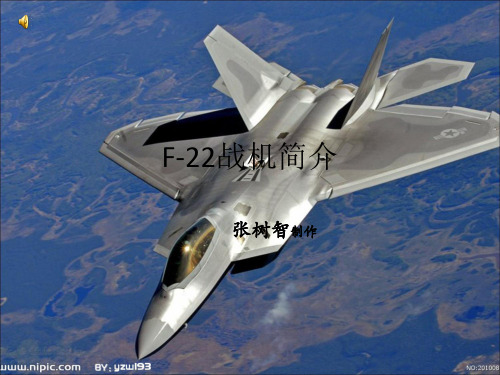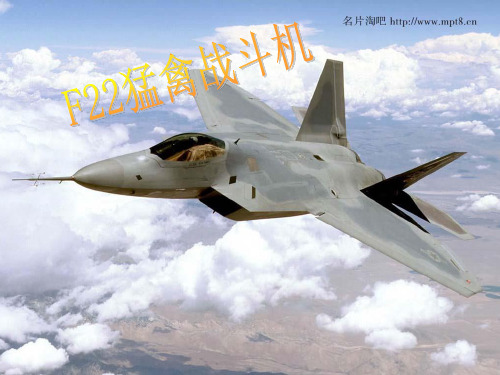美国F22猛禽战斗机介绍
F-22战机简介

F-22的发展史
• 1971年美国战术空军指挥部提出的下一代战机的研发计划。美国 战机的设计重点是对地攻击为第一优先,只要求空战时有足够自 卫的能力。 • 1979年时,美国空军将对地攻击和空战性能的重要性提升到同一 层次。 • 1982年美国空军面对苏联战斗机的快速发展,以及美国空军准备 1982 使用F-15E与F-16担任对地攻击的任务、F-117进入试飞阶段,对 地攻击的需求已经不是那么重要。当年10月,最终定案的计划正 式在最后一次公开会议上提出。ATF的技术要求一架战机具有以 下五个特点,即低可侦测性(隐身性)、高度机动性和敏捷性、 不需使用后燃器即可作超音速巡航(而不是只满足于以往使用后 燃器短时间超音速冲刺)、有效载重不低于F-15和具有飞越包括 第三世界战区在内的所有战区的能力。面对如此先进的设计要求 ,F-22必须采用一切已有的世界级航空顶尖技术。 与YF-23的竞争 试飞后,F-22被美国空军选中继续研发。
• 1986年10月31日洛克希德、波音和通用动力3家公司联 合研制小组的YF-22中标,并按要求制造两架原型机。 1990年9月29日,第1架YF-22首飞,10月26日进行了第1 次空中加油。10月30日第2架原型机进行首次飞行。11 月3日YF-22原型机进行了不使用加力的超音速飞行。随 后于11月28日在加州的中国湖海军武器试验中心首次发 射了未装弹药的“响尾蛇”导弹,12月20日在加州的太平 洋导弹试验场发射未装弹药的AIM-120“阿姆拉姆”导弹 AIM-120“ ” • 1991年8月2日空军正式授予研究洛克希德公司一份95.5 亿美元的工程发展合同,制造13架试验型飞机。1991年 12月16日,空军确定了F-22战斗机的外形,并制造了风 洞试验和测定雷达反射截面使用的模型。 • 1992年6月4日,洛克希德公司完成了F-22的设计修改。 12月27日F119的第1台工程发展阶段的发动机开始进行 试验。
f22生产原理

f22生产原理【最新版】目录1.F-22 战斗机的隐身原理2.F-22 战斗机的空气动力学设计3.F-22 战斗机的结构特点4.F-22 战斗机的先进航电系统5.F-22 战斗机的武器系统正文F-22 战斗机,全称 F-22 猛禽,是美国第五代战斗机,以其卓越的隐身性能、超音速巡航和高度机动性等性能特点,成为现代空军力量的代表。
下面我们来详细了解一下 F-22 的生产原理。
首先,F-22 的隐身原理是其最引人注目的特点之一。
F-22 采用了一种称为“蚌式”进气道的设计,可以使雷达波更难穿透其机身。
同时,F-22 的机身表面涂有特殊的吸波材料,可以进一步降低其雷达反射面积,使其在敌方雷达上几乎不可见。
其次,F-22 的空气动力学设计也是其性能的关键。
F-22 采用了一种称为“矢量推力”的技术,可以改变发动机喷口的方向,使 F-22 具有高度的机动性和控制性。
此外,F-22 的机翼采用了一种称为“菱形翼”的设计,可以减少气流对机翼的阻力,提高其飞行效率。
再者,F-22 的结构特点也值得一提。
F-22 的机身采用了一种称为“复合材料”的材料,既轻便又坚固,可以提高 F-22 的飞行性能和隐身性能。
此外,F-22 的机翼采用了一种称为“折叠式”的设计,可以在不需要时折叠起来,减少其占用的空间。
接下来,F-22 的先进航电系统也是其性能的关键。
F-22 的航电系统包括雷达、电子对抗系统、飞行控制系统等,可以实现自动化、智能化的飞行,提高 F-22 的作战效能。
最后,F-22 的武器系统也是其重要的一部分。
F-22 可以携带多种武器,包括空对空导弹、空对地导弹、炸弹等,可以满足不同的作战需求。
F22战斗机

F-22“猛禽”(英语:F-22 Raptor)战斗机是由美国洛克希德²马丁和波音联合研制的单座双发高隐身性第五代战斗机,也是世界上第一种进入服役的第五代战斗机。
F-22于2000年代中期陆续进入美国空军服役,以取代上一代的主力机种F-15鹰式战斗机。
洛克希德²马丁为主承包商,负责设计大部分机身、武器系统和F-22的最终组装。
计划合作伙伴波音则提供机翼、后机身、航空电子综合系统和培训系统。
F-22被公认为现代十大战斗机第一名。
洛克希德²马丁公司宣称,猛禽的隐身性能、灵敏性、精确度和态势感知能力结合,组合其空对空和空对地作战能力,使得它成为当今世界综合性能最佳的战斗机。
但飞机的制造成本过高、俄罗斯和中国的第五代战斗机的计划延迟导致的缺乏清晰空对空作战任务、猛禽的出口禁令和其它使用计划(包括F-35和无人机)都使得F-22的生产计划提前终止。
2009年4月,美国国防部建议停止新订单,经国会批准最终采购187架战斗机。
“2010财年国防授权法”致使缺乏生产更多F-22的资金。
2011年12月13日最后一架F-22的上线仪式在多宾斯空军预备役基地举行。
F-22战斗机发展自上个世纪七十年代末的美国先进战术战斗机计划,旨在为美国空军开发下一代空优战斗机,以对付新出现的全球威胁,取代F-15鹰式战斗机,并要在性能上全面制衡前苏联的苏-27战斗机。
F-22采用双垂尾双发单座布局。
垂尾向外倾斜27度,恰好处于一般隐身设计的边缘。
其两侧进气口装在翼前缘延伸面(边条翼)下方,与喷嘴一样,都作了抑制红外辐射的隐形设计,主翼和水平安定面采用相同的后掠角和后缘前掠角,都是小展弦比的梯形平面形,水泡型座舱盖凸出于前机身上部,全部武器都隐蔽地挂在4个内部弹舱之中。
F-22水平面上为高梯形机翼搭配一体化尾翼的综合气动力外型,包括彼此隔开很宽和并朝外倾斜的带方向舵型垂直尾翼,且水平安定面直接靠近机翼布置。
002F22A猛禽战斗机

F-22A采用双垂尾双发单座布局。机翼 上涂有吸收雷达波的材料。水泡型座舱盖, 全部武器都隐蔽地挂在4个内部弹舱之中。
F-22A(猛禽)战斗机
F-22A基本性能数据:
• 机组:1名飞行员 • 全长:18.9 米) • 翼展:13.56 米 • 空重:14,379 公斤 • 最大起飞重量:36,288公斤 • 发动机:2台普惠公司
F-22A(猛禽)战斗机
明天的战斗机
美国空军认为F/A-22 “猛禽”并非今日 所需,而是为了对付明天的威胁。考虑的是 美国空军明天的空中优势。
F-22A(猛禽)战斗机
停止生产F/A-22
2009年4月6日, 奥巴马政府时任国防部 长盖茨宣布,国防部将 向国会建议删减许多大 型武器采购计划,包括 在制造生产的187架F22战机完成后,减少乃 至停止生产这一昂贵战 机。
F-22A(猛禽)战斗机
F-22A机载武器:
• 机炮:1门20mm M61A2火神 式六管旋转机炮:
• 6枚AIM-120C先进中距空空 导弹,
• 2枚AIM-9X“响尾蛇”空空 导弹或AIM-132 空空导弹
• 空对地型:2枚GBU-32联合 直接攻击弹药(JDAM)
• 8枚GBU-39小直径炸弹(SDB) • AGM-88辐射反雷达导弹
F119-PW-100 涡扇发动机。
F-22A(猛禽)战斗机
F-22A基本性能数据:
• 最大速度:2,414公里/小 时(2.25M)
• 巡航速度:1,963公里/小 时(1.82M)
• 最大航程:2,960 公里 • 最大升限:18000 米 • 最大载重:11340千克 • 最大起飞重量:27273千克 • 空重:13636千克
(精品)世界十大顶级战斗机

F-22“猛禽”战机
F-22“猛禽”战机
俄罗斯第五代战机T-50
• T-50是一款由俄罗斯PAK-FA(“未来前线战斗机系 统”)计划下研制出的多用途第五代战斗机。T-50的 隐身性能比美国的F-22低,以换取比F-22更高的机 动性。该机于2010年1月29日进行了首次试飞,并 于2011年在莫斯科国际航空航天展上公开亮相。随 着T-50的推出,俄罗斯打破美国独占第五代战斗机 的局面,成为“第五代俱乐部”第二位成员。T-50 预计将于2016年开始服役.为单座双发重型战机,具 备隐身性能好、起降距离短、超机动性能、超音速 巡航等特点。其超音速巡航速度可达每小时1450千 米,作战半径1100千米,战斗负荷可达 6吨,内置3 个武器舱,能实现飞行性能和隐身性能的良好结合。
F/A-18"大黄蜂"战机
F/A-18"大黄蜂"战机
F/A-18"大黄蜂"战机
“阵 风”战机
• 阵风”战机具备众所周知的空对空战斗能力,是一种占尽 空中优势的战斗机。 “阵风”战机由法国军机、商务机 生产商达索飞机公司设计开发。这款飞机支持“光谱”电 子战系统,可抵御地面和空中的威胁。这款战机还可以协 助生成远距离拦截和锁定所需要的实时三维地图。
"阵风"战机
"阵风"战机
"阵风"战机
“鹰 狮”战斗机
• “鹰狮”战斗机具有八个可装载导弹和炸弹的挂载点,是一种轻型战 机,以其鸭式三角翼设计和高机动性着称。这架战机支持一个复杂的 PS-05A型脉冲多普勒X射线雷达,可以侦测120公里外的目标。
• “鹰狮”也可以通过发射空空导弹进行超视距攻击。 • JAS-39“鹰狮”是瑞典萨伯公司研制的单座全天候全高度战斗/攻击/
《航空知识》世界先进战斗机一览

美国F-22A“猛禽”战斗机(Raptor)F-22战斗机是美国洛克希德·马丁公司与波音公司为美国空军研制的21世纪初主力制空战斗机,主要用于替换美国空军现役的F-15战斗机,在美国空军武器装备发展中占有最优先的地位。
2002年9月,美空军正式将F-22改名为F/A-2 2,确立了F/A-22将兼顾制空与对地攻击双重任务。
2005年12月,美国空军兰利空军基地的第27战斗机中队装备的F-22率先达到初始作战能力(IOC)。
同时美国空军又恢复了F-22这一名称。
空军参谋长Michael Moseley周四称,F/ A不是空军的叫法。
他说:"我们把战斗机冠以F打头,众多战斗机都继承了这种叫法。
F-111具有多任务能力,F-4、F-16也具有多任务能力,F-22这种飞机也是这样的。
该机能执行空对地、空对空任务,但同时它也是空军战斗机系列飞机。
我们把这种执行空对地和空对空任务的空中优势飞机称为F-22A"。
全球目前只有美国设计制造完成两款真正的第四代战斗机FA22、F35,欧洲和俄国的战斗机不是无法达到第四代战机的全部要求,就是还在论证测试阶段。
美国FA22战斗机代表了当今技术的最高水平,是目前作战效能最强的战斗机。
F22战机1 990年首次试飞,2005年服役。
美国FA22战斗机除了采用隐身和抑制红外辐射的方法隐身外,还采用了先进的电磁波射频管理抑制技术,因为如果不采用先进的电磁波射频管理抑制技术将反而更容易被敌方发现。
FA-22采用先进的APG-7 7有源相控阵雷达,美国APG-77雷达除了传统的雷达功能外,还集成了情报侦查、电子干扰、通信等功能,并支持无源定位探测能力。
APG-77雷达的扫描速度极快,减小了被敌方截获和识别的概率,同时符合美军低可截获(LPI)要求。
A PG-77采用的低可截获技术包括根据目标探测需要控制发射功率,伪装码扩谱等。
APG-77雷达还具有非合作目标识别能力(NCTR),可不通过容易被截获的敌我识别问答装置对远方目标进行识别分类。
F22战机基本资料LV1.0

F-22Raptor(猛禽)是由美国洛 克希德· 马丁(Lockheed Martin) 设计的新一代重型隐形战斗机。也是 目前专家们所指的“第四代战斗机” (此为西方 标准,若按俄罗斯标准则为第五代)。 作为美军空战的先进战斗机,F-22将 替代麦道公司生产的F-15. 是美国于21世纪初期的主力重型 战斗机,它是目前最昂贵的战斗机。 它配备了可以不发射电磁波,用敌机 雷达波探测敌机的机载电子战系统和 探测范围极远的无源相控阵雷达, AIM-9X(Aerial Intercept Missile-9X)(响尾蛇)近程格斗 空对空导弹、AIM-120C (AMRAAM Advanced Medium-Range Air-to-Air Missile)高级中程空对空导弹、推 重比接近10的F-119涡扇引擎、隐 身性(低可探测性)等特性。
制作
武 器 1门20毫米M61A2机炮,炮口有铰接口盖。 3个内置弹舱,两个侧武器 舱可各挂1枚AIM-9近距空 空导弹,主武器舱可带1枚 AIM-120A或2枚AIM120C先进中距空空导弹或 1枚AIM-120C和1枚 GBU-32JDAM1000联合 直接攻击炸弹。另外机翼下 还有4个可承载2268千克 的外部挂架。
F22 猛禽 战斗机
基本资料
版本:LV1.0
Come on!
战机名片 基本信息 武器性能 ???
F-22战斗机(猛禽)是由 美国洛克希德· 马丁、波音和 通用动力公司联合设计的新 一代重型隐形战斗机。也是 专家们所指的“第四代战斗 机”。它将成为21世纪的 主战机种。主要任务为取得 和保持战区制空权,将是F15的后继型号。
雷达反射面积仅0.01米,精准度在6米以内,其性能如何?

雷达反射面积仅0.01米,精准度在6米以内,其性能如何?
战斗机是空军的主战战机,是当前各军事大国发展空军的重点研发方向,战斗机发展也有近百年历史,从一代到现在的五代,战斗机的性能不断提升,整体作战能力已经让的空军可单独进行作战任务,这次就来介绍下目前综合能力最强的五代机。
F-22“猛禽”为世界首款隐形五代机,也是当前综合性能最出众的五代机,“猛禽”F22的问世就像“灯塔”一样,侧面促进了后续五代机的发展,而F-22也沿袭美国一贯军工风格,高质量高标准的要求。
F-22“猛禽”拥有出色的航空电子设别,配置了大推力涡扇发动机F119,让猛禽可进行超音速航巡,最大速度为2.25马赫,时速为2400公里,有强大的机动性能,并且配置了多个外挂点,有很强的机动作战能力。
而“猛禽”最出色的是他的隐形性能,其雷达反射面积达到0.01至0.005平方米,这让当前传统脉冲雷达和大量侦查设备失效,是目前隐形性能最强的战斗机,F-22的问世也侧面奠定了美国在战斗机领域霸主的位置。
目前F-22生产线已经关闭,一共建造了187架,其原因是建造费用太高,一架F-22约在2亿美元,虽然停产,但F-22这样的数量让美国保持强大的空军实力,为美国空军主力战机。
从当前美国对空军发展定位来看,F-22猛禽大概率不会重新建造,后续空军主力以F-35多功能五代机来承担。
F-22猛禽战斗机

事实上,F22确实是普通意义上最好的战斗机,拿SU37和J10和它直接比较没有意义。F22属于美国第四代战机,与其他第三代战机的可比性很小。
F22的隐身性也受到不少质疑,有些人认为其雷达反射截面比洛马公司所说的要大得多,而且其涂层发生多次脱落事故。由于设计缺陷,美国军方每年要花上亿美元对弹射座椅进行防锈处理。
首先澄清一个误区,很多人以为现代空战还是类似于越南上空的“狗斗”。相互咬尾,然后在2000米内用cannon解决问题。实际上,这种战斗在假定的台湾海峡空战中很少真正出现,因为中距空空导弹的出现,加上全向红外导弹,使得双方真的冲到面对面的机会不多,大多会被导弹击毁。只有双方对头过后,才谈的上进入缠斗。但是由于双方都是多层次的多机,冲过头的飞机会被另外的战机用导弹击落。所以说,在正面冲突中进入缠斗的飞机会有,但是数量上不是起到对争夺制空权的绝对作用。
F22正好是在上述情形下有最大的优势,就是在中距饱和攻击之后,可以应用其极灵活的机动性做个超音速掉转,在后面的飞机掩护下迅速脱离战场。
大机群作战,协调和对战场的感知问题很重要,作为作战体系,SA(situation awareness)就是F22的另外一个重点。F22的SA是另外一个优势。F22利用小区广播技术,可以实时和其他F22、预警机,在F22上自动集成所收集到的信息。并且机上电脑会对目标进行智能评估,谁是已经被同伴锁定、攻击,谁是最有威胁,总之老美在这方面的越南经验使得他们研究的很细致。有的网友说,打掉预警机,是个好主意是这些空中老大们斗躲在战斗机的后面,而且一般会有一架战斗机护航。所以,我们的飞机冲过去打,根本不现实。你能冲过去,就说明你已经消灭了几乎所有的战斗机,这样等于没有起到使敌机群制盲的作用。还有一种方法是远程空空导弹,400公里的射程,会导致制导方面比较容易被干扰,这种技术很不成熟,况且应对这种威胁,老美使用的是高能激光进行自卫,这就是为什么在747机头上安装激光的本质原因了。没有预警机的情况下,F22会利用自身的信息优势,和系统上的优势,分享来自其他F22(主要是后面,在我方射程之外的)和其他基站的,比如F18的,军舰的,地面雷达的等等信息。至于说全波段干扰,我只能说出这个主意的网友没有学过物理学吧。
F22

结构材料
F—22是美国战斗机中使用钛合 金与复合材料最多的机型。其 中钛—64合金约36%、热定型 复合材料约24%、铝合金约16 %、钢约6%、钛—52222合金 约3%、热塑复合材料1%多些、 其它约15%。 F—22机身蒙皮全都是高强度、 耐高温的BMI复合材料。新研 究开发的高强度钴—62222合 金,初问世就用在F—22上。主 起落架使用Airmet100钢材。 武器舱门与起落架舱门使用热 塑复合材料。
• 机炮 • 1门M61A1/A2 20毫米火神炮,配 有480发炮弹 • 导弹 • 6枚AIM-120先进中程空对空导弹 • 2枚AIM-9响尾蛇导弹或AIM-132 • 2枚AIM-120先进中程空对空导弹、 2枚AIM-9响尾蛇导弹或AIM-132 • 炸弹 • 2枚GBU-32联合直接攻击弹药 (Joint Direct Attack Munition, JDAM)或 • 2枚风偏修正弹药洒布器(Wind Corrected Munitions Dispensers, WCMDs)或 • 8枚GBU-39小直径炸弹(Small Diameter Bombs, SDB)
维护
• F-22的战斗损耗率在十年 后仅为F-15的1/20(在与 俄制Su-37的虚拟战斗中, F-22和SU-37的损耗率为 1比10),维护人员将减 半,一个中队20年中的维 持成本将比F-15少5亿美 元。F-22可用超音速巡航 飞抵远方并进行“隐身超 视距作战”美国空军对此 充满信心,现正将F-22装 备部队。
性能参数
• 一般特征
• • • • • • • • • • 机组员:1名 单位造价/售价 1.2424亿美元/3.5亿美元 全长:18.9 米 翼展:13.56 米 全高:5.08 米 翼面积:78.04 平方米 空重:14,379 公斤 一般起飞重量:25,107 公斤 最大起飞重量:36,288 公斤 引擎:2具普惠(Pratt & Whitney)公司 F119-PW-100 涡轮扇发动机,每具最大后燃出力 156 kN
f22生产原理

f22生产原理(实用版)目录1.F-22 战斗机的定义和历史背景2.F-22 的生产原理和关键技术3.F-22 的生产流程和主要制造商4.F-22 的性能和作战优势5.F-22 的未来发展前景正文F-22 战斗机,全称 F-22 猛禽,是美国第五代战斗机,以其隐身性能、超音速巡航和高度机动性等先进性能而闻名于世。
自 20 世纪 80 年代开始研发以来,F-22 一直是美国空军的标志性武器之一,也是世界上最先进的战斗机之一。
F-22 的生产原理主要基于其独特的设计和制造工艺。
F-22 的设计采用了多种先进技术,如隐身技术、超音速巡航技术和高度机动性技术等。
其中,隐身技术是 F-22 最引人注目的特点之一,它采用了一种称为“蚌式”进气道的设计,可以使雷达波反射面积最小化,从而实现隐身效果。
F-22 的生产流程分为设计、制造、测试和维修等多个阶段。
其中,设计阶段主要由美国洛克希德·马丁公司负责,制造阶段则由多家公司共同参与。
洛克希德·马丁公司是 F-22 的主要制造商,负责整个战斗机的集成和总装。
此外,F-22 的生产还涉及到许多分包商,如波音公司、普惠公司等,它们分别负责制造 F-22 的机体、发动机等关键部件。
F-22 的性能和作战优势主要体现在其隐身性能、超音速巡航和高度机动性等方面。
F-22 的隐身性能可以使其在敌方雷达探测范围之外进行作战,从而大大提高其生存能力。
超音速巡航和高度机动性则可以使 F-22在空中作战中具有更高的灵活性和速度优势。
尽管 F-22 已经服役多年,但其在未来仍然有着广阔的发展前景。
随着科技的不断发展,F-22 的电子系统和武器系统等都可以不断升级,以适应新的作战需求。
此外,F-22 的生产工艺和制造技术也可以不断改进,以提高其生产效率和降低成本。
总的来说,F-22 的生产原理和制造工艺是其性能和作战优势的基石。
f22英文介绍ppt

F-22 Aerial refueling
Radar
• F-22 radar is used to detect the target active phased array system. It is through the centralized data processing system and other sensors and Avionics work together. Processor control antenna to transmit and receive beam pattern, and processing the received radar data. • Each radiating element APG-77 radar transmitter and receiver is independent innovation in the design of this system, and to ensure flexibility and small radar cross section. • f - 22雷达是用来探测目标主动相控阵系统。它是通过集中的数据 处理系统和其他传感器和航空电子设备一起工作。处理器控制天 线收发波束模式,和处理接收到的雷达数据。 • 每个辐射单元apg - 77雷达发射机和接收机自主创新在这个系统的 设计,并确保灵活性和小型雷达截面
f22发射AIM-120先进中程空空导弹
Service deployment
• November 22, 2007:The F-22 Raptor fighter first appearance, the F-22 was subordinated to Alaska ninetieth Fighter Squadron, intercepted two Russian Tu-95MS bear H bomber • In 2010, the U.S. military deployed a squadron of F-22A in Hawaii Hickam AFB • In 2007 April USA and Japan Air Self Defense warplanes launched a joint flight training. The F22 for the first time the military base stationed in outside of USA. • In July to August 20, F-22 were stationed in The Territory of Guahan Andersen AFB to Participated "(Jungle Shield)" exercises.
“猛禽”诞生记

“猛禽”诞生记背 景:F-22 “猛禽”是由美国洛克希德?马丁(Lockheed Martin)、波音(Boeing)和通用动力公司联合研制的新一代(第四代)重型隐形战斗机。
它配备了强大的有源相控阵雷达、AIM-9X “响尾蛇”先进近程格斗空对空导弹、AIM-120C先进中程空对空导弹以及推重比达到10的F-119涡扇发动机。
F-22在设计上具备超音速巡航(不开加力状态下)、超视距作战、高机动性及低可探测性等性能。
该机作战能力为现役F-15数倍,将会在较长的一段时间里成为世界重型战斗机的霸主。
该机所采用的设计和标准也对后续的各国第四代战机研制产生了深远的影响。
本文将全程展现一架F-22静模的制作过程,期待与各位同好交流。
套件现在市面上可供选择的F-22静模套材比较全,从1/48、1/72到1/144的都有。
笔者偏爱大比例,所以选择了1/48的。
该比例的套件有三款,“意大利”、爱德美和长谷川。
“意大利”公司出品的一款上市较早,细节方面表现一般,外形上也有一些错误;其次是爱德美的,除了机头形状问题很大其余部分较为准确,而且一大张水贴包括了F-22几乎所有的中队徽标;长谷川的上市最晚,外形准确、细节一流,但个人感觉该款模型机身蒙皮效果太过夸张。
综合考虑,本次制作选用了爱德美出品的套件。
因为隐形战机机型本身的光板特性,不容易在机身表面细节上做过多改动,所以制作时着重对机头、起落架、座舱、弹舱、机背蒙皮、尾喷以及地勤装备几个方面进行了改造。
机头众多模友在该套件试模照片放出的第一时间便指出了此款的机头显得很别扭――肥短。
因此外部改造的重中之重就是修机头。
先找两张角度较好的实机机头侧面和上面的照片,然后以深色背景拍了两张相同角度的套件照片(两张照片的拍摄位置都要尽量远,以最大限度减少透视所产生的变形),最后用Photoshop软件把实机和套件的照片稍作调整后叠加在一起(图1)。
差别显而易见,模型的机头短了差不多3毫米,还原到实机就是近15厘米!为此,先在机头最前端钻孔,然后插入大头针,露出3毫米的距离,这样就确定了长度。
美国F-22“猛禽”战斗机综合化航空电子系统概述

该雷达包括5个主要部件:相控阵/波束控制器、含24个电路模块的雷达支持电子组件、含5个电路模块的射频接收机、含3个电路模块的相控阵电源和安装支架。
雷达计算机软件由4部分组成:雷达处理和管理软件,提供顶层雷达工作方式的控制和管理;雷达支持电子控制程序,提供接收机构形和校准;相控阵电源控制程序,提供对电源工作的监控和管理;波束控制器控制程序,实现对波束指向的计算。
F-22“猛禽”战斗机是根据美国空军“全球作战、全球到达,全球力量”的战略思想而设计的,要求它能在未来空空、空地战场环境中夺取空中优势,应是美国空军夺取制空权的主力战斗机,将取代F-15战斗机。该战斗机的主要特点如下:
(4)座舱采来“一平六下”显示体制,所有作战信息通过平显和多功能显示器显示,为飞行员提供关键的飞行及作战信息,显著降低了飞行员的工作负担;
(5)通过机内自检(BIT)和系统重构,使系统具有容错能力,提高了系统的可靠性和可维修性。
五、F-22战斗机航空电子系统的主要设备
F-22飞机航空电子系统的主要设备包括雷达、红外搜索与跟踪(IRST)(未来发展项目)、电子战、通信导航识别、2个通用综合处理器、控制和显示装置、惯性基准系统及外挂管理系统。
1.通信/导航/识别系统
5.具有隐身能力
F-22的武器都装在机身里,使用时才打开武器舱门,这使机身下部很平坦,从而减少了雷达波的反射,同时还采用了能减少雷达反射截面的复合材料和灰色隐身涂料,其雷达反射截面积只有F-15的几十分之一,从而在进行空战时可以先敌发现、先敌攻击,大大增强作战的突然性、隐蔽性,提高作战效能。
美国洛克希德·马丁公司研制的F-22“猛禽”战斗机是于21世纪初开始服役的第四代战斗机的典型代表,被誉为21世纪的主力战斗机,该机先进的航空电子系统是完成各种作战任务的关键。本文将对其技战术特点等方面进行论述,并提出相关发展建议。
f22材料

f22材料F22 Raptor是一款美国空军的战斗机,很多人对它的材料充满了好奇。
F22 Raptor的材料经过了精心的选择和开发,旨在提供优异的性能和可靠性。
F22 Raptor是世界上第一架使用大量复合材料的战斗机之一。
复合材料由两种或多种不同的材料组成,以发挥各种材料的优点并弥补其缺点。
对于F22 Raptor,复合材料主要由碳纤维和环氧树脂组成。
碳纤维是一种非常轻而强大的材料,它的强度和刚度比钢高的多。
这使得机身和翼面板更加坚固且减少了重量。
这种材料的优点之一是它的无电磁干扰性能。
与金属相比,碳纤维材料具有更低的雷达反射率,使得F22 Raptor更难被雷达探测到。
除了碳纤维,F22 Raptor还使用了环氧树脂作为结合剂。
环氧树脂是一种具有优异粘合和高温耐受性的材料。
它能够保持碳纤维的强度和刚度,并且能够抵抗高温和氧化。
F22 Raptor的推进系统也使用了一种先进的复合材料。
其喷气发动机的涡轮叶片由单晶合金制成,这种合金具有极高的耐热性和抗拉强度。
这种材料可以承受高温和高压的环境,并且具有较好的空气动力学特性。
此外,F22 Raptor的座舱也应用了一些特殊的材料。
座舱的透明材料由聚碳酸酯制成,这种材料具有较好的光学性能和耐冲击性。
座椅背板的防弹板由钛合金制成,这种材料具有很高的强度和硬度,能够提供优异的防护性能。
总的来说,F22 Raptor采用了多种先进的复合材料和金属材料,以实现优异的性能和可靠性。
这些材料的应用使得F22 Raptor成为一款隐形、高效且具有出色机动性的战斗机。
随着技术的不断发展,未来可能还会有更多新材料的应用,使得战斗机的性能进一步提升。
F22飞机资料

美国F-22猛禽战斗机(英文:F-22 Raptor),由美国洛克希德²马丁、波音和通用动力公司联合设计的新一代重型隐形战斗机,主要任务是取得并确保战区的制空权。
也是现今唯一投入使用的第四代战斗机。
F-22于2000年开始陆续进入美国空军服役,以取代上一代的主力机种F-15鹰式战斗机。
joint design of a new generation of heavy stealth fighter, the main task is to achieve and make sure that the war zone of air.And now only be put into use of the fourth generation fighter.F - 22 begin to enter the United States air force in 2000, the main to replace the previous generation models F - 15 hawk fighters.F-22战机价格昂贵,单机造价超过1.4亿美元,是世界上唯一的一种现役“第四代战斗机”。
具备隐身、超音速巡航、超机动性、超视距空战的“4S”能力。
确立了新一代战斗机的技术标杆。
F - 22 planes is expensive, standalone cost more than $140 million, is one of the world's only active "fourth generation fighter".With stealth, supersonic cruise, super maneuverability, beyond visual range air combat ability of "4 s".Established the technical standard of a new generation of fighter jets.作为世界上第一款投入服役的第四代战斗机,F-22在航空史上具有划时代的意义,一问世就受到了全世界广泛的关注,众多航空爱好者、五角大楼和美国空军也对此寄予了厚望。
世界上最早服役的五代战机

翼负荷
378公斤/平方米
作战推重比
1.4
最大过载
-3.0/﹢9.0G
武器装备
?
机炮
1门M61A2 20毫米六管火神炮,配有480发炮弹
导弹
AIM-120中距弹.AIM-9格斗弹.
炸弹
GBU-10、GBU-12、GBU-16,CBU-59、Mk-80等
其他武器
F/A-22除执行空中优势任务外,也能使用联合直接攻击弹药等精确制导武器进行精确对地攻击。由于隐身和超音速巡航的需要,F/A-22的基本武器装备安置在机内。不过它也有用于挂副油箱和导弹的4个翼下挂点,用于在非隐身状态挂载副油箱和武器。
F/A-22战斗机原计划装备1门新研制的先进技术机炮,但在该型机炮实用前,装备的是1门改进的M61A2机炮。机炮安装在飞机右进气口上方的炮舱内。射击时,炮舱的前部舱门必须向后打开,以便射击和排除废气。炮舱内除安装M61A2机炮外,还安装有洛克希德·马丁公司研制的无壳弹药线性供弹系统,并备有480发炮弹、2枚风偏修正弹药洒布器(Wind Corrected Munitions Dispensers,简称WCMDs)或 1枚GBU-39小直径炸弹(Small Diameter Bombs,简称SDB)或AGM-88辐射反雷达导弹。另外机翼下还有4个可承载2268千克的外部挂架。
RCS面积
约0.01㎡(估算值)
机身构造
材料
F-22机身蒙皮全都是高强度、耐高温的BMI复合材料。新研究开
F-22美国猛禽战斗机(14张)发的高强度钴-62合金,初问世就用在F-22上。主起落架使用钢材。武器舱门与起落架舱门使用热塑复合材料。F/A-22是美国战斗机中使用钛合金与复合材料最多的机型。其中钛-64合金约36%、热定型复合材料约24%、铝合金约16%、钢约6%、钛-52222合金约3%、热塑复合材料约1%、其它约15%。
f22英文介绍ppt

• 2008年7月中至8月初,F-22A进驻关岛安德森空军基地,参与“丛林之盾(Jungle Shield)”的演习。
• In January 7, 2011, the air force announced USA deployed 15 F-22 fighters to Okinawa Prefecture of Japan Kadena temporary deployment of four months to ensure safety and stability to the Pacific Region. • In April 1, 2013, F-22 jointed America Korea "vulture" field maneuver exercise In South Korea. • 2011年1月7日,美国空军宣布15 f - 22战斗机 部署日本冲绳县嘉手纳临时部署四个月,以 确保对太平洋地区安全与稳定。 • 2013年4月1日,美国f – 22加入韩国“秃鹰”军演。
Technical characteristics
• f - 22采用双垂直布局。垂直尾翼倾斜27度外,就在边缘的隐身设计。 • 双方的进气口是安排在机翼前沿扩展(列板翼)在表面的接触和喷 嘴,使旨在抑制红外辐射的吸收
• the wing and horizontal stabilizer adopts the same sweep angle and the trailing edge sweep angle, are trapezoid flat than the small aspect, bubble canopy cover out of the front upper fuselage, all weapons are concealed hanging on the 4 internal bomb bay. • This is cockpit • 机翼和水平稳定器采用相同的扫描角和后缘 扫描角,比小梯形平方面,泡沫的树冠覆盖上机 身前,所有的武器都藏挂在4内部炸弹舱。 • 这是驾驶舱
F22战斗机简介

2.翼负荷。
翼负荷则是指每单位的机翼所提供的 升力能提供多少公斤的力量
3.涡轮扇发动机
涡轮扇发动机(Turbofan Engine) 的主要特点 是其压缩扇叶的面积大很多,除了作为压缩空气 的用途之外,同时也具有螺旋桨的作用,能将部 分吸入的空气通过喷射引擎的外围向后推。
(二)武器配备比较表
项目
翼负荷 最大 G 限 满载内载燃料 现役国
322 公斤/平方公尺 −3.0/+ 约 (约八十五头刚出生的小象) 目前只有美国,部署在本土阿拉斯加
造价
US$1亿1000万(约NT36亿)(还持续再涨高)
2.F-22A的技术特点
F-22A的垂直尾翼向外倾斜27度,处于低可侦测性设计的边 缘。两侧进气口装在翼前缘延伸面(边条翼)下方,与喷嘴一 样,都作了抑制红外线辐射的匿踪设计。
(2)GBU-39小直径炸弹(简称SDB)装备有全球卫星定位系 统(简称GPS)和惯性导航系统(简称INS)。GBU-39,可 有效降低对周遭无辜的伤害。
4.空对地炸弹:
(1)GBU-32 Mk 83联合直接攻击弹药 (简称 JDAM) 是波音公 司为美军开发的一种航空炸弹配件,装在由飞机投放的传 统炸弹上,将本来无法控制的传统航空炸弹转变为可控制 的,并能在恶劣气象条件下使用的的精确导引武器。此弹 药的导引功能是由炸弹尾翼控制附件及全球定位系统或惯 性导引系统提供。
目前F-22A的主要任务为取得和保持战区制空权,将 是F-15的后继型号。
F-22猛禽式戰機
1.F-22A的性能与基本资料
极速
2,414 公里/时(约等于一秒钟跑4圈北投国小的操场)
巡航速度 最大升限
1,963 公里/时 19,812 公尺(约是39栋101大楼叠起来)
- 1、下载文档前请自行甄别文档内容的完整性,平台不提供额外的编辑、内容补充、找答案等附加服务。
- 2、"仅部分预览"的文档,不可在线预览部分如存在完整性等问题,可反馈申请退款(可完整预览的文档不适用该条件!)。
- 3、如文档侵犯您的权益,请联系客服反馈,我们会尽快为您处理(人工客服工作时间:9:00-18:30)。
F22 DesignThe Lockheed Martin F-22 Raptor is a single-seat, twin-engine, all weather stealth tactical fighter aircraft developed for the United States Air Force (USAF). The result of the USAF's Advanced Tactical Fighter program, the aircraft was designed primarily as an air superiority fighter, but has additional capabilities including ground attack, electronic warfare, and signals intelligence roles.[6] Lockheed Martin is the prime contractor and is responsible for the majority of the airframe, weapon systems, and final assembly of the F-22, while program partner Boeing provides the wings, aft fuselage, avionics integration, and training systems.The aircraft was variously designated F-22 and F/A-22 prior to formally entering service in December 2005 as the F-22A. Despite a protracted development as well as operational issues, the USAF considers the F-22 a critical component of its tactical air power, and states that the aircraft is unmatched by any known or projected fighter. The Raptor's combination of stealth, aerodynamic performance, and situational awareness gives the aircraft unprecedented air combat capabilities.[8] Air Chief Marshal Angus Houston, former Chief of the Australian Defence Force, said in 2004 that the "F-22 will be the most outstanding fighter plane ever built."The high cost of the aircraft, a lack of clear air-to-air missions due to delays inRussian and Chinese fighter programs, a ban on exports, and development of the more versatile and lower cost F-35 led to the end of F-22 production.[N 1] A final procurement tally of 187 operational production aircraft was established in 2009 and the last F-22 was delivered to the USAF in 2012.OverviewThe F-22 Raptor is a fifth generation fighter that is considered fourth-generation in stealth aircraft technology by the USAF. It is the first operational aircraft to combine supercruise, maneuverability, stealth, and sensor fusion into a single platform. The Raptor has large shoulder-mounted diamond wings, four empennage surfaces, and a retractable tricycle landing gear. Flight control surfaces include leading and trailing edge flaps, ailerons, rudders on the canted vertical stabilizers, and all-moving horizontal tails; these control surfaces also serve as the speed brake.The aircraft's dual afterburning Pratt & Whitney F119-PW-100 turbofan engines are placed close together and incorporate pitch axis thrust vectoring nozzles with a range of ±20 degrees; each engine has a maximum thrust in the 35,000 lbf (156 kN) class. The F-22's thrust to weight ratio in typical combat configuration is nearly at unity in maximum military power and 1.25 in full afterburner. Maximum speed without external stores is estimated to be Mach 1.82 during supercruise and greater than Mach 2 with afterburners.The F-22 is among only a few aircraft that can supercruise, or sustainedsupersonic flight without using fuel-inefficient afterburners; targets can be intercepted which subsonic aircraft would lack the speed to pursue and an afterburner-dependent aircraft would lack the fuel to reach. The Raptor's high operating altitude is also a significant tactical advantage over prior fighters.[109] The use of internal weapons bays allows the aircraft to maintain comparatively higher performance over most other aircraft due to a lack of drag from external stores. The F-22's structure contains extensive amounts of high-strength materials to withstand stress and heat of sustained supersonic flight. Respectively, titanium alloys and composites comprise 39% and 24% of the aircraft's structural weight.The F-22 is highly maneuverable at both supersonic and subsonic speeds. Computerized fly-by-wire control system and full authority digital engine control (FADEC) make the aircraft highly departure resistant and enable it to remain controllable at aggressive pilot inputs. The Raptor's relaxed stability and thrust vectoring allow the aircraft to turn tightly, and perform very high alpha (angle of attack) maneuvers such as the Herbst maneuver (J-turn) and Pugachev's Cobra. The F-22 is also capable of maintaining over 60°alpha while having some roll control.The F-22's aerodynamic performance, sensor fusion, and stealth work together for increased effectiveness. Altitude, speed, and advanced active and passive sensors allow targets to be spotted at considerable ranges and increase weapons range. Altitude and speed also complement stealth's effectiveness by increasing distance between the aircraft and ground defenses and giving defensive systems less time to react.AvionicsKey avionics include BAE Systems EI&S AN/ALR-94 radar warning receiver (RWR),[116] Lockheed Martin AN/AAR-56 Infra-Red and Ultra-Violet Missile Launch Detector (MLD) and Northrop Grumman AN/APG-77 Active Electronically Scanned Array (AESA) radar. The MLD features six sensors to provide full spherical infrared coverage.[84] The RWR is a passive radar detector with more than 30 antennas are blended into the wings and fuselage for all-round coverage. Tom Burbage, former F-22 program head at Lockheed Martin, described it as "the most technically complex piece of equipment on the aircraft." The range of the RWR (250+ nmi) exceeds the radar's, and can cue radar emissions to be confined to a narrow beam (down to 2° by 2° in azimuth and elevation) to increase stealth.The AN/APG-77 radar features a low-observable, active-aperture, electronically scanned array that can track multiple targets under any weather conditions. Radar emissions can also be focused to overload enemy sensors as an electronic-attack capability. The radar changes frequencies more than 1,000 times per second to lower interception probability and has an estimated range of 125–150 miles, though planned upgrades will allow a range of 250 miles (400 km) or more in narrow beams. Radar information is processed by two Raytheon Common Integrated Processor (CIP)s, each capable of processing up to 10.5 billion instructions per second. In a process known as sensor fusion, data from the radar, other sensors, and external systems is filtered and combined by the CIP into a common view, reducing pilot workload.The F-22's ability to operate close to the battlefield gives the aircraft threat detection and identification capability comparative with the RC-135 Rivet Joint, and the ability to function as a "mini-AWACS", though the radar is less powerful than those of dedicated platforms. The F-22 can designate targets for allies, and determine whether two friendly aircraft are targeting the same aircraft. This radar system can sometimes identify targets "many times quicker than the AWACS".The IEEE-1394B data bus developed for the F-22 was derived from thecommercial IEEE-1394 "FireWire" bus system. In 2007, the F-22's radar was used as a wireless data transceiver during tests, transmitting data at 548 megabits per second and receiving at gigabit speed, far faster than the Link 16 system.The F-22's software has some 1.7 million lines of code, the majority involving processing radar data. Former Secretary of the USAF Michael Wynne blamed the use of the DoD's Ada for cost overruns and delays on many military projects, including the F-22. Cyberattacks on subcontractors have reportedly raised doubts about the security of the F-22's systems and combat-effectiveness. In 2009, former Navy Secretary John Lehman considered the F-22 to be safe from cyberattack, citing the age of its IBM software.CockpitCockpit of the F-22, showing instruments, head up display and throttle topThe F-22 has a glass cockpit with all-digital flight instruments. The monochrome head-up display offers a wide field of view and serves as a primary flight instrument; information is also displayed upon six color liquid crystal display (LCD) panels. The primary flight controls are a force-sensitive side-stick controller and a pair of throttles. The USAF initially wanted to implement direct voice input (DVI) controls, but this was judged to be too technically risky and was abandoned. The canopy's dimensions are approximately 140 inches long, 45 inches wide, and 27 inches tall (355 cm x 115 cm x 69 cm) and weighs 360 pounds.The F-22 has integrated radio functionality, the signal processing systems are virtualized rather than as a separate hardware module. There has been several reports on the F-22's inability to communicate with other aircraft, and funding cuts have affected the development of the MADL data link. Voice communication is possible, but not data transfer.The integrated control panel (ICP) is a keypad system for entering communications, navigation, and autopilot data. Two 3 in × 4 in (7.6 cm × 10.2 cm) up-front displays located around the ICP are used to display integrated caution advisory/warning data, communications, navigation and identification (CNI) data and also serve as the stand-by flight instrumentation group and fuel quantity indicator. The stand-by flight group displays an artificial horizon, for basic instrument meteorological conditions. The 8 in ×8 in (20 cm ×20 cm) primary multi-function display (PMFD) is located under the ICP, and is used for navigation and situation assessment. Three 6.25 in × 6.25 in (15.9 cm × 15.9 cm) secondary multi-function displays are located around the PMFD for tactical information and stores management.The ejection seat is a version of the ACES II (Advanced Concept Ejection Seat) commonly used in USAF aircraft, with a center-mounted ejection control.[135] The F-22 has a complex life support system, which includes the on-board oxygen generation system (OBOGS), protective pilot garments, and a breathing regulator/anti-g (BRAG) valve controlling flow and pressure to the pilot's mask and garments. The protective garments are designed to protect against chemical/biological hazards and cold-water immersion, to counter g-forces and low pressure at high altitudes, and to provide thermal relief. It was developed under the Advanced Technology Anti-G Suit (ATAGS) project.[136] Suspicions regarding the performance of the OBOGS and life support equipment have been raised by several mishaps, including a fatal crash.ArmamentAIM-120 AMRAAM (right) fitted in a weapons bay of an F-22The Raptor has three internal weapons bays: a large bay on the bottom of the fuselage, and two smaller bays on the sides of the fuselage, aft of the engine intakes. It can carry six medium range missiles in the center bay and one short–range missile in each side bay; Four of the medium range missiles can be replaced with two bomb racks that can each carry one medium-size or four smaller bombs. Carrying armaments internally maintains the aircraft's stealth and minimizes additional drag. Missile launches require the bay doors to be open for less than a second, during which hydraulic arms push missiles clear of the aircraft; this is to reduce vulnerability to detection and to deploy missiles during high speed flight.The F-22 can also carry air-to-surface weapons such as bombs with Joint Direct Attack Munition (JDAM) guidance and the Small-Diameter Bomb, but cannot self-designate for laser-guided weapons.[141] Internal air-to-surface ordnance is limited to 2,000 lb.[142] An internally mounted M61A2 Vulcan 20 mm cannon is embedded in the right wing root with the muzzle covered by a door to maintain stealth.[143] The radar projection of the cannon fire's path is displayed on the pilot's head-up display.F-22 with external weapons pylonsThe F-22's high cruise speed and altitude increase the effective ranges of its munitions, it has 50% greater employment range for the AIM-120 AMRAAM than prior platforms, and range will be further extended with the eventual introduction of the AIM-120D. While specifics are classified, it is expected that JDAMs employed by F-22s will have twice or more the effective range of legacy platforms. In testing, an F-22 dropped a 1,000 lb (450 kg) JDAM from 50,000 feet (15,000 m) while cruising at Mach 1.5, striking a moving target 24 miles (39 km) away.While the F-22 typically carries weapons internally, the wings include four hardpoints, each rated to handle 5,000 lb (2,300 kg). Each hardpoint has a pylon that can carry a detachable 600 gallon fuel tank or a launcher holding two air-air missiles. The use of external stores degrades the F-22's stealth, maneuverability and speed. The two inner hardpoints are "plumbed" for external fuel tanks; the hardpoints can be jettisoned in flight to maximize the aircraft's stealth after exhausting external stores. A stealth ordnance pod and pylon is being developed to carry additional weapons internally.StealthFor stealth, the F-22 carries weapons in internal bays. The doors for the center and side bays are open; note the six LAU-142/A AMRAAM Vertical Ejection Launchers The F-22 was designed to be highly difficult to detect and track by radar. Measures to reduce its radar signature include airframe shaping such as planform alignment of edges, fixed-geometry serpentine inlets that prevent line-of-sight of the engine faces from any exterior view, use of radar absorbent material (RAM), and attention to detail such as hinges and pilot helmets that could provide a radar return. The F-22 was also designed to have decreased radio, heat and noise emissions as well as reduced visibility to the naked eye. The aircraft's flat thrust vectoring nozzle reduces infrared emissions to mitigate the threat of infrared homing ("heat seeking") surface-to-air or air-to-air missiles.[150] Additional measures to reduce the infrared signature include special paint and active cooling of leading edges to manage the heat buildup from supersonic flight.Compared to previous stealth designs like the F-117, the F-22 is less reliant on RAM, which are maintenance-intensive and susceptible to adverse weather conditions. Unlike the B-2, which requires climate-controlled hangars, the F-22 can undergo repairs on the flight line or in a normal hangar. The F-22 features a Signature Assessment System which delivers warnings when the radar signature is degraded and necessitates repair.[109] The F-22's exact radar cross-section (RCS) is classified; however, in 2009 Lockheed Martin released information indicating it has an RCS (from certain angles) of −40 dBsm – equivalent to the radar reflection of a "steel marble".[152] Effectively maintaining the stealth features can decrease the F-22's mission capable rate to 62–70%.The effectiveness of the stealth characteristics is difficult to gauge. The RCS value is a restrictive measurement of the aircraft's frontal or side area from the perspective of a static radar. When an aircraft maneuvers it exposes a completely different set of angles and surface area, potentially increasing radar observability. Furthermore, the F-22's stealth contouring and radar absorbent materials are chiefly effective against high-frequency radars, usually found on other aircraft. The effects of Rayleigh scattering and resonance mean that low-frequency radars, employed by weather radars and ground warning stations, are more likely to detect the F-22 due to its physical size. However, such radars are also large, conspicuous, and less precise. Additionally, while faint or fleeting radar contacts make defenders aware that a stealth aircraft is present, reliably vectoringinterception to attack the aircraft is much more challenging.[155] According to the USAF an F-22 surprised an Iranian F-4 Phantom II that was attempting to intercept an American UAV, despite Iran's claim of having military VHF radar coverage over the Persian Gulf.Specifications (F-22A)Orthographically projected diagram of the F-22AF-22 Raptor tail feathersUSAF poster of key F-22 features and armamentData from USAF, F-22 Raptor Team web site Manufacturers' dataAviation Week, and Journal of Electronic DefenseGeneral characteristicsCrew: 1Length: 62 ft 1 in (18.92 m)Wingspan: 44 ft 6 in (13.56 m)Height: 16 ft 8 in (5.08 m)Wing area: 840 ft² (78.04 m²)Airfoil: NACA 64A?05.92 root, NACA 64A?04.29 tipEmpty weight: 43,340 lb (19,700 kg)Loaded weight: 64,840 lb (29,410 kg)Max. takeoff weight: 83,500 lb (38,000 kg)Powerplant: 2 × Pratt & Whitney F119-PW-100 pitch thrust vectoring turbofans Dry thrust: 26,000 lb (116 kN) eachThrust with afterburner: 35,000+ lb (156+ kN) eachFuel capacity: 18,000 lb (8,200 kg) internally, or 26,000 lb (12,000 kg) with two external fuel tanksPerformanceMaximum speed:At altitude: Mach 2.25 (1,500 mph, 2,410 km/h)Supercruise: Mach 1.82 (1,220 mph, 1,960 km/h)Range: >1,600 nmi (1,840 mi, 2,960 km) with 2 external fuel tanksCombat radius: 410 nmi (with 100 nmi in supercruise) (470 mi, 760 km)Ferry range: 2,000 mi (1,740 nmi, 3,220 km)Service ceiling: >65,000 ft (20,000 m)Wing loading: 77.2 lb/ft² (377 kg/m²)Thrust/weight: 1.08Maximum design g-load: −3.0/+9.0 gArmamentGuns: 1× 20 mm (0.787 in) M61A2 Vulcan 6-barrel Gatling cannon in right wing root, 480 roundsAir to air loadout:6× AIM-120 AMRAAM2× AIM-9 SidewinderAir to ground loadout:2× 1,000 lb (450 kg) JDAM or 8× 250 lb (110 kg) GBU-39 Small Diameter Bombs2× AIM-120 AMRAAM2× AIM-9 SidewinderHardpoints: 4× under-wing pylon stations can be fitted to carry 600 U.S. gallon drop tanks or weapons, each with a capacity of 5,000 lb (2,270 kg).AvionicsAN/APG-77 radar: 125–150 miles (200–240 km) against 1 m2 (11 sq ft) targets (estimated range)AN/AAR-56 Missile Launch Detector (MLD)AN/ALR-94 radar warning receiver (RWR): 250 nmi (463 km) or more detection rangeMJU-39/40 flares for protection against IR missiles。
